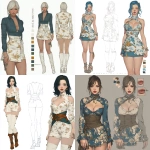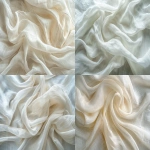Explore the Best AI Image Gallery

Beyond the Canvas: Wearable Tech as a Catalyst for Artistic Evolution
The realm of art has always been driven by innovation, a constant exploration of new mediums and expressions. Today, wearable technology stands at the forefront of this evolution, offering artists an exciting playground to experiment with and redefine creativity. From immersive installations to interactive performances, wearable tech is transforming how we create, experience, and interact with art.
Bridging the Gap Between Artist and Audience
Wearable technology has the power to bridge the gap between artist and audience, creating a more intimate and engaging experience. Imagine attending an art exhibition where you can don a haptic vest that responds to the emotions conveyed in a sculpture or wear augmented reality glasses that overlay interactive elements onto a painting.
This technology allows artists to tap into multiple senses, enriching the viewing experience and fostering a deeper connection between the artwork and the viewer. Interactive installations powered by wearable sensors can respond to audience movement, creating a dynamic and evolving work of art that is constantly shaped by its viewers.
New Dimensions in Artistic Expression
Wearable tech empowers artists to explore new dimensions of expression. Artists can utilize motion-tracking devices to translate body movements into visual or auditory elements, blurring the lines between performer and artwork. Biometric sensors can capture physiological responses to art, incorporating real-time data into the creative process.
Imagine a performance where dancers heartbeats influence the lighting design or a sculpture that reacts to the breathing patterns of its viewers. These possibilities unlock a realm of artistic innovation where technology becomes an extension of the artists vision.
Challenges and Ethical Considerations
While the potential of wearable tech in art is immense, it also raises important ethical considerations.
Data Privacy and Security
Wearable devices collect vast amounts of personal data, including biometric information. It is crucial to ensure that this data is handled responsibly, with transparent consent processes and robust security measures in place.
Accessibility and Inclusivity
Art should be accessible to everyone. Its important to design wearable tech solutions that are inclusive and cater to diverse needs and abilities.
Ownership and Authorship
As AI and machine learning become more integrated into creative processes, questions arise about authorship and ownership of artworks generated using these technologies. Establishing clear guidelines and frameworks is essential to navigate this evolving landscape.
Future Trends in Wearable Art
The future of wearable art holds exciting possibilities:
Immersive Storytelling
Wearable devices can create immersive storytelling experiences that transport viewers into different worlds and narratives. Imagine exploring a historical site through an augmented reality app or experiencing a fictional story firsthand through haptic feedback.
Personalized Art Experiences
AI algorithms can analyze user preferences and tailor art experiences to individual tastes. Imagine wearable devices that recommend artworks based on your mood, style, or even your biometrics.
Collaborative Creativity
Wearable tech can facilitate real-time collaboration between artists, regardless of their location. Imagine multiple users contributing to a single artwork through synchronized gestures or shared sensory experiences.
Conclusion
Wearable technology is transforming the creative landscape, empowering artists to push boundaries and engage audiences in unprecedented ways. By embracing these innovations while addressing ethical considerations, we can unlock a future where art becomes even more immersive, interactive, and meaningful.


](https://images.ai-img.art/thumbnails/150/92db9158526805f4e438e5531d51913400855d6281c3e9cfb60e2251a26f9c62.webp)















](https://images.ai-img.art/thumbnails/150/b280cd776d11e9ba6130542924a673299ee17d1d4cfb287df0445e71165211b4.webp)
](https://images.ai-img.art/thumbnails/150/564796a8f7e0059faedfce41fa3ac5bfa4c4065f231473bd5e3901336c92ffff.webp)




](https://images.ai-img.art/thumbnails/150/9852ce8d1febd9d8344467b42688c54f3619e023e3b8515019ad9de85efc7f46.webp)







](https://images.ai-img.art/thumbnails/150/f3bef6b1c4c93eadc3cf2209f9062f676a6fd94018da7483cb40120fe1a9e60c.webp)
















